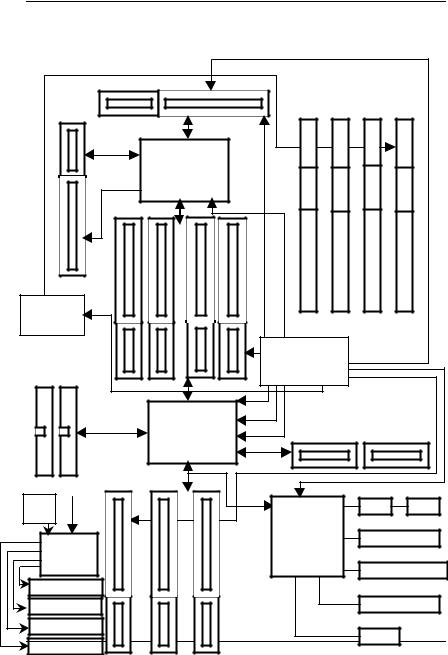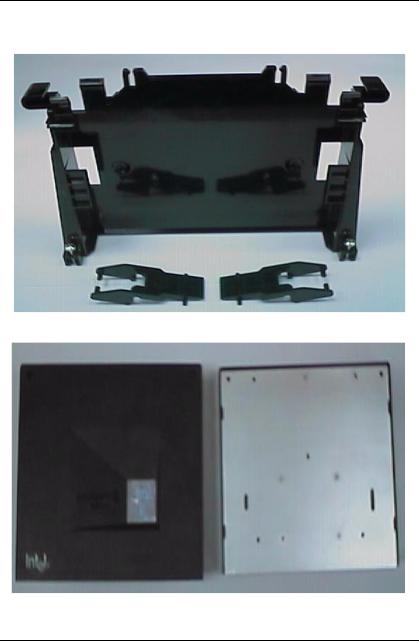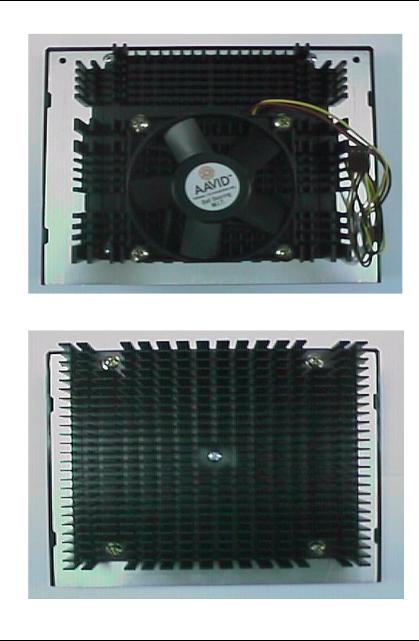Gigabyte GA-6GXU Manual

6GXU
TABLE OF CONTENTS
1. |
INTRODUCTION |
|
|
1.1. PREFACE............................................................................................................ |
1-1 |
|
1.2. KEY FEATURES ................................................................................................. |
1-1 |
|
1.3. PERFORMANCE LIST........................................................................................ |
1-2 |
|
1.4. BLOCK DIAGRAM............................................................................................... |
1-3 |
|
1.5. INTRODUCE THE Pentiumâ II / III XEON SLOT2 Processor ........................... |
1-4 |
|
1.6. What is AGP? ...................................................................................................... |
1-6 |
2. |
SPECIFICATION |
|
|
2.1. HARDWARE ....................................................................................................... |
2-1 |
|
2.2. SOFTWARE........................................................................................................ |
2-2 |
|
2.3. ENVIRONMENT.................................................................................................. |
2-2 |
3.HARDWARE INSTALLATION
3.1. UNPACKING ....................................................................................................... |
3-1 |
|
3.2. MAINBOARD LAYOUT ....................................................................................... |
3-2 |
|
3.3. QUICK REFERENCE FOR JUMPERS & CONNECTORS................................ |
3-2 |
|
3.4. DRAM INSTALLATION ....................................................................................... |
3-6 |
|
3.5. CPU SPEED SETUP........................................................................................... |
3-6 |
|
3.6. CMOS RTC & ISA CFG CMOS SRAM............................................................... |
3-7 |
|
3.7. SPEAKER CONNECTOR INSTALLATION........................................................ |
3-7 |
|
3.8. HARDWARE RESET SWITCH CONNECTOR INSTALLATION ...................... |
3-7 |
|
3.9. POWER LED CONNECTOR INSTALLATION................................................... |
3-7 |
|
|
|
|
1 |
|
|

|
Table of Contents |
|
3.10. IDE & ATAPI DEVICE INSTALLATION ............................................................ |
3-7 |
|
3.11. PERIPHERAL DEVICE INSTALLATION .......................................................... |
3-7 |
|
3.12. KEYBOARD & PS/2 MOUSE INSTALLATION................................................. |
3-8 |
|
3.13. SCSI DEVICE INSTALLATION......................................................................... |
3-8 |
|
4. BIOS CONFIGURATION |
|
|
4.1. ENTERING SETUP............................................................................................. |
4-1 |
|
4.2. CONTROL KEYS ................................................................................................ |
4-1 |
|
4.3. GETTING HELP .................................................................................................. |
4-2 |
|
4.3.1. Main Menu............................................................................................... |
4-2 |
|
4.3.2. Status Page Setup Menu / Option Page Setup Menu.............................. |
4-2 |
|
4.4. THE MAIN MENU................................................................................................ |
4-2 |
|
4.5. STANDARD CMOS SETUP MENU.................................................................... |
4-4 |
|
4.6. BIOS FEATURES SETUP .................................................................................. |
4-8 |
|
4.7. CHIPSET FEATURES SETUP ........................................................................... |
4-14 |
|
4.8. POWER MANAGEMENT SETUP ...................................................................... |
4-18 |
|
4.9. PNP/PCI CONFIGURATION .............................................................................. |
4-21 |
|
4.10. LOAD BIOS DEFAULTS ................................................................................... |
4-23 |
|
4.11. LOAD PERFORMANCE DEFAULTS ............................................................... |
4-24 |
|
4.12. INTEGRATED PERIPHERALS......................................................................... |
4-25 |
|
4.13. SUPERVISOR PASSWORD/USER PASSWORD .......................................... |
4-31 |
|
4.14. IDE HDD AUTO DETECTION .......................................................................... |
4-32 |
|
4.15. SAVE & EXIT SETUP ....................................................................................... |
4-33 |
|
4.16. EXIT WITHOUT SAVING ................................................................................. |
4-34 |
|
2

6GXU
1. INTRODUCTION
1.1. PREFACE
Welcome to use the 6GXU motherboard. It is a Pentiumâ II/III XEON SLOT2 Processor based PC / AT compatible system with AGP / PCI / ISA Bus, and has been designed to be the fastest PC / AT system. There are some new features allow you to operate the system with just the performance you want.
This manual also explains how to install the motherboard for operation, and how to set up your CMOS CONFIGURATION with BIOS SETUP program.
1.2. KEY FEATURES
qIntel PentiumâII / III XEON SLOT2 Processor based PC / AT compatible mainboard.
qCPU1 supports PentiumâII / III XEON SLOT2 processor running at 400650MHz.
qIntel 440GX chipset, Supports AGP / SDRAM / Ultra DMA/33 IDE / Wake on LAN / Keyboard and PS/2 Mouse Power On / ACPI features.
qSupports Intel LDCMâ Network Manageability.
qSupports 4xDIMMs using 3.3V SDRAM DIMM module.
qSupports 8 MB - 2 GB SDRAM memory on board.
qSupports ECC or Non-ECC type DRAM module.
q1xAGP slot, 4xPCI Bus slots, 3xISA Bus slots.
qSupports 2 channels Ultra DMA/33 IDE ports for 4 IDE Devices.
qSupports both Ultra SCSI, Ultra Wide SCSI and two Ultra II SCSI ports.
qSupports 2xCOM (16550), 1xLPT (EPP / ECP), 1x Floppy port.
qSupports 2xUSB ports, 1xPS/2 Mouse, 1xPS/2 Keyboard.
qLicensed AWARD BIOS, 2M bits FLASH RAM.
qSupport Dual BIOS.
1-1

Introduction
q 30.5 cm x 25 cm ATX SIZE form factor, 4 layers PCB.
1.3. PERFORMANCE LIST
The following performance data list is the testing results of some popular benchmark testing programs.
These data are just referred by users, and there is no responsibility for different testing data values gotten by users. (The different Hardware & Software configuration will result in different benchmark testing results.)
|
· CPU |
Pentiumâ II XEON SLOT2 450MHz |
|
|
|
· DRAM |
(128x2)MB SDRAM (MITSUBISHI M5M4V64S30ATP-8) |
|
|
|
· CACHE SIZE |
2MB included in CPU |
|
|
|
· DISPLAY |
GA-630 AGP Display Card (16MB SGRAM) |
|
|
|
· STORAGE |
Onboard Ultra-II SCSI (Seagate ST39102LW) |
|
|
|
· O.S. |
Windows NT™ 4.0 |
|
|
|
· DRIVER |
Display Driver at 1024 x 768 x 64 colors x 75Hz. |
|
|
|
|
Adaptec PCI Ultra II SCSI Driver |
|
|
|
Processor |
Intel Pentiumâ II XEON SLOT2 |
|
|
|
450MHz (100*4.5) |
|
||
|
|
|
|
|
|
|
|
|
|
|
Winbench99 |
|
|
|
|
CPU mark32 |
1270 |
|
|
|
|
|
|
|
|
FPU Winmark |
2350 |
|
|
|
|
|
|
|
|
Business Disk |
5730 |
|
|
|
|
|
|
|
|
Hi-End Disk |
400 |
|
|
|
|
|
|
|
|
Business Graphics |
234 |
|
|
|
|
|
|
|
|
Hi-End Graphics |
11100 |
|
|
|
|
|
|
|
|
Winstone99 |
|
|
|
|
|
Business |
35.2 |
|
|
|
|
|
|
|
|
Hi-End |
31.8 |
|
|
|
|
|
|
|
|
|
|
|
|
|
|
1-2 |
|

6GXU |
|
|
|
|
|
1.4. BLOCK DIAGRAM |
|
|
|
||
|
|
|
|
|
14.318MHz |
|
|
SLOT2 |
|
3.3V EDO/SDRAM |
|
|
|
|
|
||
AGP |
|
|
|
DIMM Sockets |
|
|
|
|
|
|
|
|
|
Host Bus |
|
|
|
|
|
INTEL |
|
100 |
|
|
AGP Bus |
82443GX |
100 |
MHz |
|
|
66MHz |
CHIPSET |
MHz |
|
|
|
|
|
|
||
|
|
DRAM Bus |
|
||
|
|
|
|
||
Clock Gen |
|
|
|
|
|
Buffer |
|
|
|
|
|
|
|
|
33 |
100MHz |
|
|
|
|
MHz |
Clock Gen |
|
|
|
|
|
||
Ultra DMA/33 |
|
|
|
|
|
IDE Ports |
|
PCI Bus |
|
|
|
|
|
|
|
|
|
|
100 |
|
|
|
|
|
MHz |
PIIX4 |
48MHz |
|
|
|
|
|
|
||
|
IDE Bus |
82371EB |
14.318MHz |
USB Ports |
|
|
CHIPSET |
|
|
48MHz |
|
|
|
|
|
||
|
|
|
|
|
|
|
|
|
USB Bus |
|
|
PCI Bus |
ISA Bus |
14.318MHz |
COM Ports |
||
|
|
||||
40MHz |
|
|
|
|
|
|
|
|
I/O |
|
|
OSC |
|
|
|
|
|
|
|
|
|
CHIPSET |
LPT Port |
SCSI |
|
|
|
Winbond |
|
|
|
|
83977EF |
|
|
CHIPSET |
|
|
|
Floppy Port |
|
|
|
|
|
||
AIC-7890P |
|
|
|
|
|
EXT. LVD |
|
|
|
|
Keyboard |
INT. LVD |
|
|
|
|
|
Ultra Wide SCSI |
|
|
|
PS/2 Mouse |
|
|
|
|
|
||
Ultra SCSI Port |
|
1-3 |
|
|
|
|
|
|
|
|
|

Introduction
1.5. INTRODUCE THE Pentiumâ II / III XEON SLOT2 Processor & AGP
Figure 1:Retention Mechanism & attach Mount
Figure 2:OEM Pentiumâ II / III XEON SLOT2 Processor
1-4

6GXU
Figure 3:Heatsink / FAN & Heat sink support for OEM Pentiumâ II/ III XEON SLOT2 Processor
Figure 4:Boxed Pentiumâ II / III XEON SLOT2 Processor & Heat sink
1-5

Introduction
support
1.6 What is AGP?
The Accelerated Graphics Port (AGP) is a new port on the Host-To-PCI bridge device that supports an AGP port. The main purpose of the AGP port is to provide fast access to system memory.
The AGP port can be used either as fast PCI port (32-bits at 66MHz vs. 32bits at 33MHz) or as an AGP port which supports 2x data-rate, a read queue, and side band addressing. When the 2x-data rate is used the port can transmit data at 533MB/sec (66.6*2*4). The read-queue can be used to pipeline reads – removing the effects of the reads-latency. Side band addressing can be used to transmit the data address on a separate line in order to speed up the transaction.
1-6

6GXU
2. SPECIFICATION
2.1. HARDWARE
∙CPU
∙PROTECTION
∙ SPEED
−Pentiumâ II / III XEON SLOT2 processor 400 – 650 MHz.
−330 pins 100MHz XEON SLOT2 on board.
−Speaker Alarm when detect "CPU FAN Failure" or “CPU Overheat” .
−Automatically slow down CPU speed when "CPU Overheat".
−Intel LDCMâ supported.
−H/W monitor power status (±5V, ±12V, 5V SB,VGTL , CPU voltage & CMOS battery voltage).(Optional)
−CPU Over Voltage .
−100 MHz system speed.
−66 MHz AGP bus speed. (2X mode 133MHz)
−33 MHz PCI-Bus speed.
−8 MHz AT bus speed.
∙DRAM MEMORY − 4 banks 168 pins DIMM module sockets on board.
−Use 8 / 16 / 32 / 64 / 128 / 256 / 512 MB DIMM module DRAM.
−8 ~ 2 GB SDRAM.
−Supports 3.3V SDRAM.
−Supports ECC or Non-ECC type DRAM.
−32 KB 1st cache memory included in CPU.
∙CACHE MEMORY
−512KB/1MB/2MB 2nd cache in CPU.
−Supports DIB speed mode for L2 Cache.
−4 33MHz Master / Slave PCI-BUS.
∙I/O BUS SLOTS
−3 8MHz 16 bits ISA BUS.
−1 66MHz / 133MHz AGP bus.
∙ IDE PORTS |
− 2 Ultra DMA/33 Bus Master IDE channels on |
|
board.(Using IRQ14,15) |
|
− Support Mode 3,4 IDE & ATAPI CD – ROM. |
|
|
|
2-1 |
